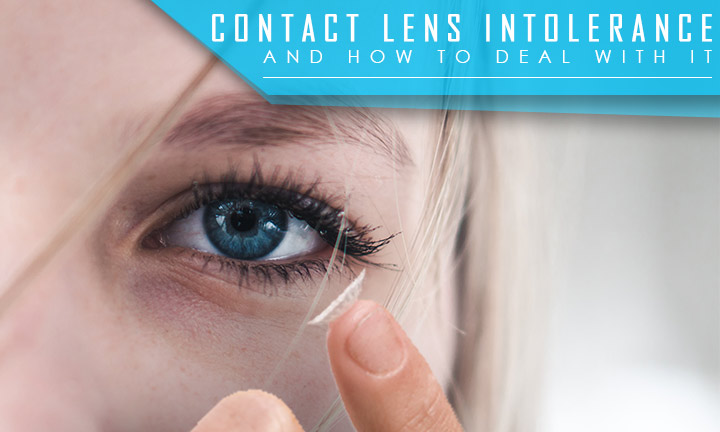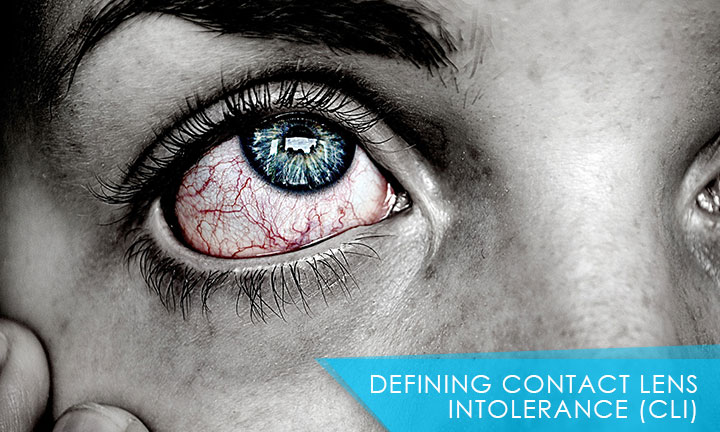11th, February 2019 | Oh Jinna
Contact Lens Intolerance and How To Deal With It

Here at OhMyLens, we wanted to offer the best contact lens for you. It is also our initiative to raise awareness of certain conditions that may concern you. Apart from some common eye problems that we discussed in the previous articles, this time we have — contact lens intolerance.
Check out this article to know how contact lens intolerance can affect you and how can you possibly get away with it.
DEFINING CONTACT LENS INTOLERANCE (CLI)

Also called, CLI, contact lense intolerance describe eye’s inability to tolerate contact lenses.
Contact lens intolerance occurs when you can no longer wear contact lenses without feeling dryness, irritation, or tearing.
Nearly 41 million Americans rely on contact lenses for temporary vision correction.
According to latest statistics, close to 16 percent of those contact lens wearers are forced to stop wearing lenses because of Contact Lens Intolerance.
Most contact lens wearers who have common refractive errors, such as nearsightedness, farsightedness, and astigmatism, have experienced some form of contact lens intolerance.
WHAT CAUSES CLI?
The American Academy of Ophthalmology says there are many factors that can contribute to contact lens intolerance. Some of the most common factors are the following:
- Dry Eye Syndrome
You have dry eye syndrome when your eyes dry up and feel very irritated. This usually happens when your eyes don’t produce the right quality or right amount of tears.
Since Dry Eye Syndrome often develops as you age, you may develop CLI even after many years of successful and comfortable contact lens wear.
- Meibomian Gland Dysfunction
The meibomian glands are located where the eyelashes are found. These are oil glands that are significant part of the eye’s tear film.
If there is some blockage or other problem of the meibomian glands, it can cause the tears to evaporate too quickly. This is a leading cause of dry eye syndrome that can further lead to CLI.
- Blepharitis
This condition happens when a person has more bacteria at the base of their eyelashes than the normal.
When you have blepharitis, you may experience red and swollen eyelids. Disruption of the meibomian gland can cause blepharitis.
This condition is difficult to treat but doesn’t cause permanent damage to the eyesight. However, if it continues to be infected this can cause CLI.
External Causes
- Digital Eye Strain
Eye strain is also called as asthenopia. Asthenopia is becoming a common eye condition, but people who constantly use their eyes intensely for a prolonged period of time are more prone to this condition.
Statistics show that a person staring at a computer screen or smart phone blinks significantly less than average.
With contact lenses in, the tear film is thinner, causing tears to evaporate more quickly, and there may sometimes be friction between the eyelid and the lens whenever you do blink.
All of these factors lead to increased possibility of developing CLI.
- Environmental Allergens
Allergies are one final instance in which Contact Lens Intolerance may present itself.
As a result of allergens in the air, such as pet dander, smoke or pollen, your body’s immune system can sometimes be tricked into kicking into overdrive, releasing a chemical called histamine into your system which, among other things, dries out your eyes.
Again, adding contact lenses into the equation further dries out your eyes, making it very difficult to wear your contacts comfortably.
All the mentioned conditions make the contact lens surface eye less hospitable to lens wear which can lead to discomfort and inflammation.
But with proper diagnosis and treatment, contact lens intolerance may not be a problem at all.
There are safe and effective ways that you can once again enjoy the convenience of using contact lenses compared to eyeglasses.
HOW DO YOU KNOW IF YOU HAVE CLI?
First and foremost, only your eye doctor can be able to correctly diagnose CLI after a comprehensive exam.
Most of the time, it can be very time-consuming to diagnose CLI since there are a lot of factors that need to be considered. Once diagnosed, CLI can be effectively addressed.
Here are some of the most important factors that eye doctors need to consider to be able to diagnose a patient with a CLI.
- Eye solution
- Lens fit and material
- Patient behavior
- Patient’s underlying medical conditions
Symptoms of Contact Lens Intolerance
Some people experience the symptoms of CLI a few times a year, while others suffer the symptoms on a daily basis and can no longer wear contact lenses.
This is often when people search for an alternative solution to their contact lenses.
The level of discomfort people experience can range from mild to severe, with symptoms including:
- Dryness, itchiness, or scratchiness
- Redness
- Irritation
- Inflammation
- Pain, stinging, or other discomfort when applying contact lenses
- Corneal abrasions
- Corneal ulcers
HOW CAN CLI BE TREATED?
If you are already feeling subtle signs of CLI like dry, irritated eye and red eyes upon wearing contact lenses, the following immediate treatments can be done to reduce the symptoms:
- Switch Lens Care Solution
Even if you clean your lenses every day and take good care of them, your body may become eventually intolerant of them.
There are specialized eye solution available in the market that is designed for removal of foreign material that can be found in the lids and lashes.
Some other factors that causes CLI are store brand or generic contact lenses solutions.
- Follow Replacement Schedule
Over wearing your lenses beyond the wearing schedule prescribed by your eye doctor can also contribute to CLI.
Consult your eye doctor regularly to make sure that fit of your contact lenses.
- Reduce Wearing Time
CLI can occur regardless of how long you are used to wearing them. In some cases, CLI occur even after years of uneventful use.
You might notice the first signs and symptoms of CLI when you constantly yearn to remove your contact lenses earlier than your usual day to day schedule.
If you have CLI, you tend to prefer your glasses again more often than you used to. Eventually, those who suffer with CLI stop wearing contact lenses completely after some time.
If you have been wearing contact lenses for years and suddenly develop symptoms of CLI, it is possible that pre-existing dry eye or blepharitis has been exacerbated by contact lens use which can also cause CLI.
Other Tips to Lower Risk of CLI
- Proper hygiene
Proper hygiene is very important when you are wearing contact lenses. Make sure to wash your hands thoroughly before handling lenses.
According to the FDA, if contact lenses are not cleaned properly, changed appropriately, are worn too long or handled improperly, some sight-threatening infections can occur.
Eye pain, blurred vision, and redness are all signs of an inflammation or infection and should be treated immediately by an ophthalmologist.
Keep your eyelids clean and free from microorganisms or debris that may cause redness and irritation.
- Do not sleep in your lenses.
When you wear contact lenses, a limited amount of oxygen gets to your eye. And if you close your eyes for prolonged period of time, it cannot get much needed oxygen from the air.
Upon examination through magnification, the cornea of the eyes shows swelling and microcysts because of oxygen starvation.
If this happens too long, this can lead to eye infection and corneal ulcers. This condition can lead to permanent blindness.
EFFECT OF CONTACT LENS TO EYE ENVIRONMENT
According to scientists, contact lenses may be damaging your eyes, only if you wear them for too long.
Studies from New York University suggest that there are significant differences between the ecosystems of the eyes of the people who wear contact lenses and those who don’t.
In their study, they took hundreds of swabs of people’s eye conjunctiva, which lines the eyelids and covers the white part of your eyes, and swabs of the skin directly under the eye.
Results show that those people who wore contacts had more bacterial diversity in the skin beneath their eye.
Aside from that, there is a higher amount of different kinds of bacteria on the surface of the eye itself.
The bacteria present in the eyes are three times the proportion of the bacteria in the skin.
These findings help in understanding the reason why contact lens wearer are more prone to eye infections.
LATEST MEDICAL ADVANCES IN TREATING CLI
Some recent studies can be the new addition to the ongoing developments in eye care treatment.
A study from Korea in 2018 suggest that if it’s possible in the future to create smart contact lenses.
These contact lenses will be capable of monitoring the physiological information of the eye and tear fluid.
Furthermore, the advances in wearable electronics combined with wireless communications.
Aside from that here are some new developments in eye care that you should want to be aware of:
- For those suffering blepharitis: There is a device called BlephEx that can help you.
It is a hand piece used to spin a medical grade micro-sponge along the edge of your eyelids and lashes to remove debris in your eyelids.
- For those suffering meibomian gland dysfunction, there is LipiFlow. It uses a precise amount of heat and controlled pressure to the inner eyelid to unblock clogged meibomian glands.
- There is also an eye solution that can help you remove the bacteria and mites in your eyes. These products are from Avenova® from NovaBay Pharmaceuticals.

Leave a Reply
You must be logged in to post a comment.